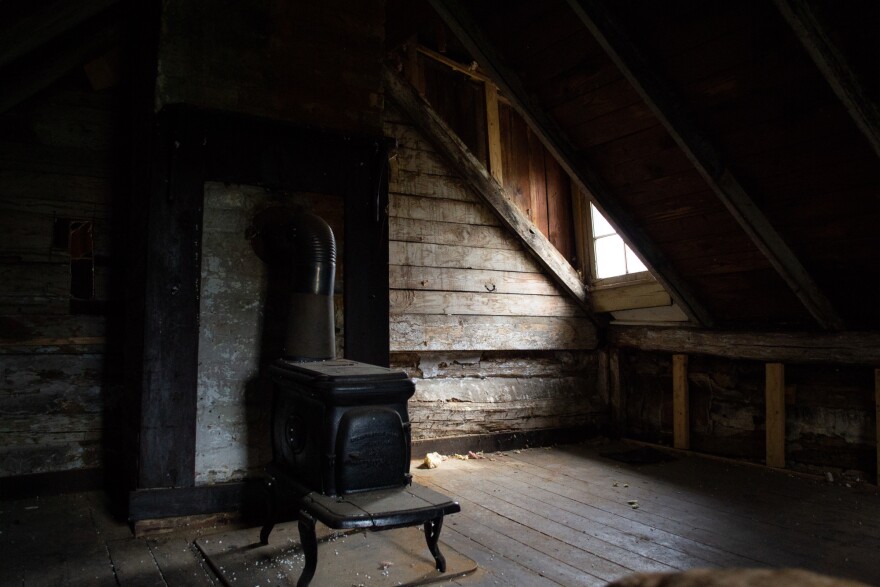This spring, the Historic Staunton Foundation began preserving a home with a rich and storied past – much of which is just now being unearthed. WMRA's Randi B. Hagi picks up with the conclusion of this story.
In part one, we started a journey tracing Edmund Cabell and his family back through the 1800s, to the log house he built in Staunton just after the Civil War and the abolition of slavery. The home where he and Eveline raised most of their nine kids was passed down to their son Wash. In 1920, a fire broke out after Wash's 16-year-old twins, Mary and Emma, hung some laundry over the kitchen stove, possibly causing the clothesline to break.
[footsteps, dog trotting by]
FRANK STRASSLER: We are stepping into a kitchen and this kitchen was constructed in the 1920s. My understanding is there was one here earlier, but there was a fire …
Frank Strassler, accompanied on this tour by his dog, Otto, is the executive director of the Historic Staunton Foundation, which is studying and preserving the home.

STRASSLER: … We can see the charred logs – they're not destroyed, they're just charred. … And once they develop that char, it actually insulates a heavy timber.
First, they'll seal holes in the walls and windows, and improve drainage to prevent further water damage.
STRASSLER: And it looks a little daunting, but in reality, when you survey the whole, the entire building, you'll find that the logs are actually in fairly good condition, but we'll have some limited replacement to do. The big key with any historic house is not to just jump into doing something – is to plan it very carefully.
One part of that plan is an archaeological study – led by Dennis Blanton of James Madison University. In early April, he had students digging small test pits and sifting through the earth for artifacts.

[students talking, digging, shaking dirt through sieves]
DENNIS BLANTON: And I can tell you right away that there's not only a story in the ground, but it's a very rich story. We've been finding a lot of information, you know, just on day one.
Ali Tierney pulled out a fragment of what may have been a medicine bottle.
ALI TIERNEY: So that's an 1800s, roughly, and they used a lot of different colors, and this one's like an aqua kind of color. … So this one, they had a mold that they would blow the glass into, and then press, and then they would make, they'd handmake the neck part to close it off. So when you look at that, if the seam ends sort of right at the neck, that's how you can tell.

Fellow student Sean Mennard was excited that his group happened to dig into an old trash pit, or midden.
SEAN MENNARD: Trash gives an archaeologist the ability to look into their life, their day to day home life, what they were doing in the kitchen, what they did for recreation, especially here, because we found a lot of ceramics … porcelain, salt-glaze, redware, we found brick, cinders, charcoal, we found some buttons that would go on clothing, we found a piece of ceramic that actually had gold in the decoration.
The section of the home Edmund originally built is on the east end of the house – the family had doubled its square footage by the turn of the century. A woodstove still sits in a bedroom.
STRASSLER: It's interesting up at this side of the house. [walking up wooden stairs] Typical log house loft or upstairs bedroom. We're sitting right underneath the gable roof with exposed rafters.

Lori Tate told me that Mama Emma had one upstairs bedroom, and Ma Mary had the other – accessed by its own staircase on the other side of the house. Around age 18, Emma Cabell married a man nearly 20 years her senior. After her husband's death, she returned to the old homeplace. Mary Evalina Cabell never married, working as a cook and domestic helper until her death in 1972. Emma remained in the home until the late 80s, when she moved into the Oak Hill nursing home. The Historic Staunton Foundation bought the house for the first time then, in 1987, and resold it to the Cabells' goddaughter, Jean Tate, and her husband Oliver.
LORI TATE: They were the up-keepers of the property, and my parents were just known around Staunton for doing stuff. My brother and my father were the caretakers of Fairview Cemetery until they passed.
Oliver Tate died in 2009, and Jean passed away two years ago. Faced with difficult family dynamics around her mother's estate, Lori sold the property to a local builder who wanted to restore the house. He ended up selling it back to the Historic Staunton Foundation. While Lori would have preferred to keep the home in the family, she said the most important thing is that it's preserved.

[birds singing]
TATE: I just want it to be restored back to its beautiful little self, down in that little gully. … And you know, just make it look just homey again. My Mom always went over there every year, and she did the front and had flowers out … and tried to make the yard look presentable. It always just looked so inviting when you used to come by there all the time.
The work and care of generations live on at the Cabell house over 150 years after it was built – in the clay and lime daubing between each log, the windows looking out over ivy-covered trees, and the garden hyacinth and tulips that still bloom, wild, each spring.

Thank you to the following researchers for their assistance –
- Kathy Cabell Terlesky, The Cabell Family Society, Inc.
- Donna Huffer, Augusta County Historical Society
- Whitney Rhodes, Augusta County Courthouse
- Octavia Starbuck, Amherst County Museum & Historical Society



